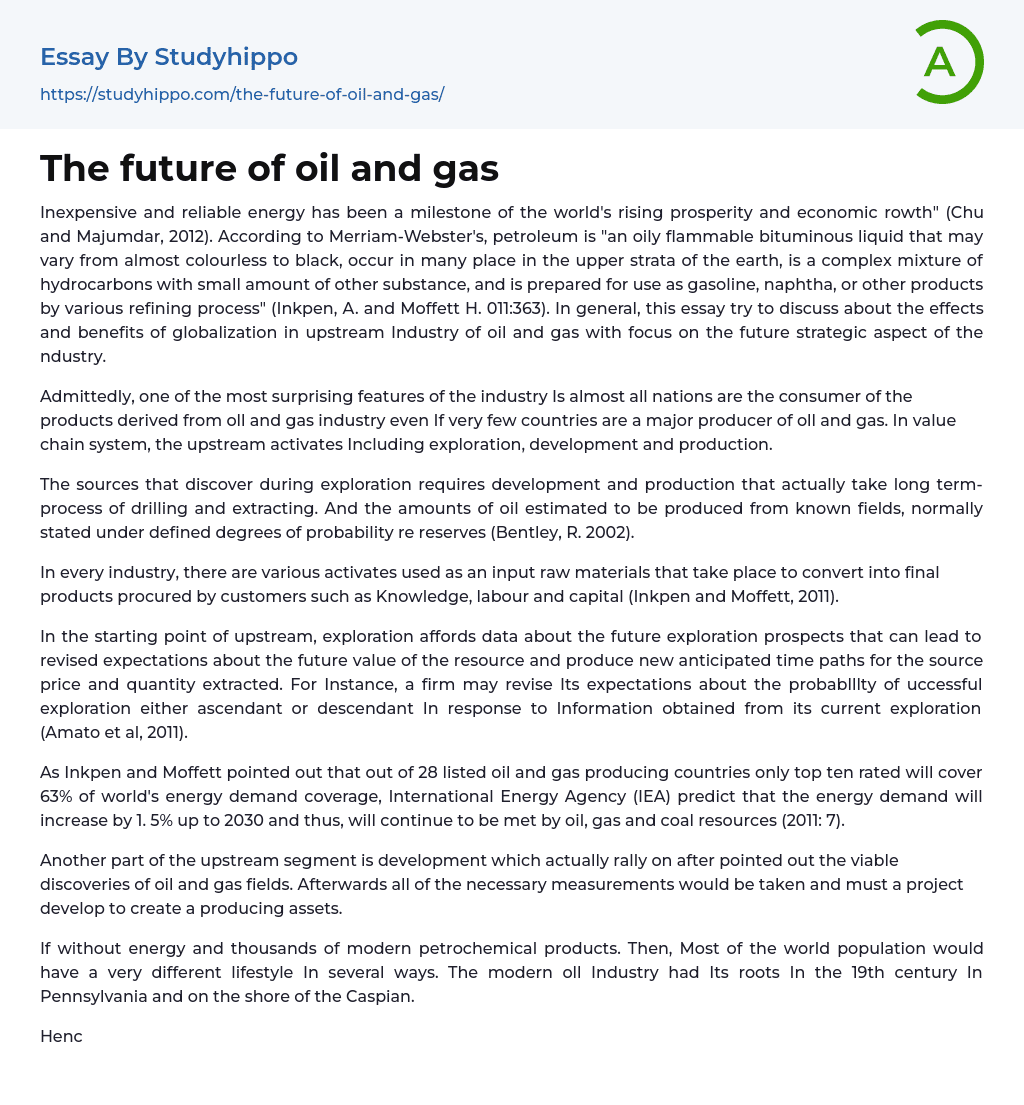Chu and Majumdar (2012) stress that affordable and reliable energy is crucial for global economic growth. Petroleum, a complex mixture of hydrocarbons with small amounts of other substances, is refined into products such as gasoline and naphtha (Merriam-Webster). Inkpen and Moffett (2011) explore how globalization impacts the oil and gas industry's upstream sector while highlighting strategic considerations for the future. Although only a few countries are major producers, almost all nations consume related products. The value chain encompasses exploration, development, production, drilling, extraction from discovered sources - which can be time-consuming - with estimated reserves often presented under defined probability degrees by Bentley (2002). Various industries use inputs like knowledge, labor, capital to create final products for customers as explained by Inkpen and Moffett (2011). Exploration in the industry provides prospects for future explorat
...ion that may change expectations about a resource's potential value (Amato et al., 2011). According to the International Energy Agency (IEA), oil, gas, and coal resources will continue to meet increasing energy demand up to 2030 by 1.5% (Inkpen and Moffett, 2011:7); however, the top ten oil and gas producing countries are expected to cover 63% of the world's energy demand. After discovering an oil or gas field that is viable economically speaking,the project planning process begins as development commences towards creating production assets.
Inkpen and Moffett (2011:3) argue that oil and gas are fundamental to national security and prosperity in almost every country. Before converting resources into frugally recoverable reserves through development, proper project planning is a necessary step for decision-making and industry management, as emphasized by Inkpen and Moffett. Bringing proved reserves to commercial production requires clearly defined expenditure (2011:151).
The roots of the oil industry can be traced back to Pennsylvania and the Caspian in the 19th century while subterranean mining has been known since ancient times. Energy and petrochemical products are critical components of modern lifestyles, with their absence significantly altering it. Production is just one facet of upstream operations; locating, extracting, transporting oil to refineries is vital for success as an exploration organization. Demand from derivative products drives demand but supply shocks have led to price changes (Inkpen & Moffett). Historically, four categories contribute to volatility in prices which cause rapid shifts in supply - including massive new discoveries like those made in Texas during the 1930s resulting in falling prices below production costs.Throughout the 1970s and 1980s, OPEC took action to limit collective producer output in response to rising market demand and political pressure. This led to an increase in prices once again. Additionally, man-made destruction resulting from conflicts such as the Arab-Israel conflict or Persian Gulf War of 1991 also had a significant impact on energy consumption and drove prices up. The effects of natural disasters like Hurricane Katrina were also felt when production facilities off Mexico's Gulf Coast were destroyed, leading to a rise in market price. All these factors have contributed to an ongoing cycle between scarcity and sufficiency as global demands continue to increase. It is widely believed that oil and gas are commodities with worldwide reach, and companies have a critical responsibility to promote sustainable economic growth by ensuring that the production and consumption of these resources are balanced.
- Energy Development essays
- The elements essays
- Voltage essays
- Solar Energy essays
- Nuclear Energy essays
- Alternative Energy essays
- Atom essays
- Big Bang Theory essays
- Density essays
- Electricity essays
- Energy essays
- Force essays
- Heat essays
- Light essays
- Motion essays
- Nuclear Power essays
- Physiology essays
- Sound essays
- Speed essays
- Temperature essays
- Thermodynamics essays
- Acceptance essays
- Age Of Enlightenment essays
- Child Observation essays
- Confucianism essays
- Conscience essays
- Critical Reflection essays
- Destiny essays
- Determinism essays
- Empiricism essays
- Environmentalism essays
- Epistemology essays
- Ethics essays
- Ethos essays
- Existence essays
- Existentialism essays
- Fate essays
- Free Will essays
- Functionalism essays
- Future essays
- Good And Evil essays
- Human Nature essays
- Individualism essays
- Meaning Of Life essays
- Metaphysics essays
- Natural Law essays
- Personal Philosophy essays
- Philosophers essays
- Philosophy Of Life essays
- Political Philosophy essays




